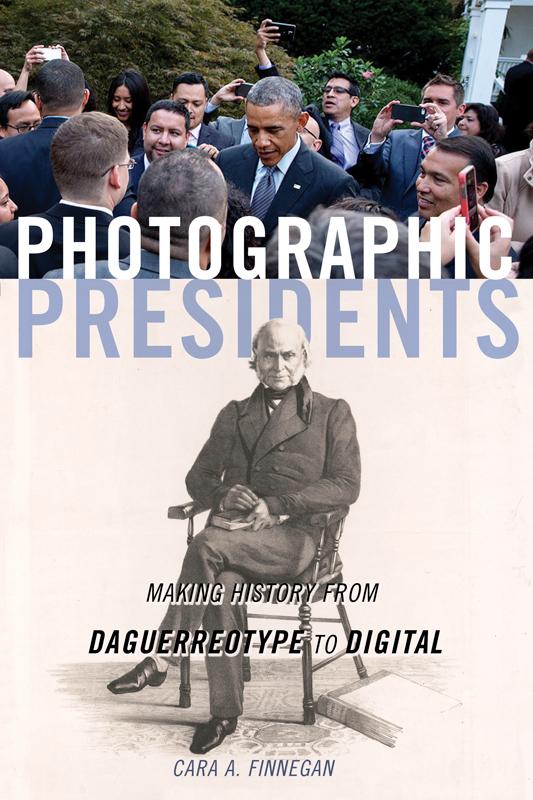
Credit: Book cover courtesy the University of Illinois Press. Obama image from an official White House photo by Pete Souza. Adams image a lithograph based on an 1843 daguerreotype by Philip…
CHAMPAIGN, Ill. — From the advent of photography to the age of social media, U.S. presidents have been among the most common subjects for the camera. So what better way to tell a story of the medium’s evolution than through those historical figures.
That was the thinking of Cara Finnegan in writing Photographic Presidents: Making History from Daguerreotype to Digital, publishing this spring.
The title might suggest a coffee table book filled with iconic photos of iconic presidents, but there are few. Finnegan, instead, is telling a history of photography and its influence through its interactions with the nation’s chief executives, and at key moments of transformation in the technology.
“I wanted to account for what happened when presidents met new media, and how both of them were changed as a result,” said Finnegan, a communication professor at the University of Illinois Urbana-Champaign.
Her previous work has examined the effect of photos of Abraham Lincoln, the Civil War dead and Barack Obama’s Flickr site, among other topics. Her new book received a National Endowment for the Humanities Open Book Award.
Photography was a new medium not just in 1839, with the invention of the daguerreotype – a light-sensitive plate that required a long exposure and could not be duplicated – but with each transformation in technology that followed. Halftone reproduction brought photos to the mass media. Better cameras and film later made it possible to capture the unaware in unflattering ways. The digital era made it possible to shoot, share and manipulate photos with ease.
Finnegan intersperses chapters on the changing technology with chapters on presidents and presidential events that illustrate photography’s capabilities, limitations and effects at those points in time, and how those helped shape public values around its use.
One constant throughout, she said: “Presidents always wanted to control their image.” They worried about what looked presidential and what didn’t, as well as the “camera fiends” who might capture the embarrassing pose.
“I think of presidents as kind of the visual equivalent of canaries in the coal mine,” Finnegan said, “or warning bells for what the medium might be doing with and to us at any moment.”
That was true with one of the first presidents to sit in front of a camera – actually a former president – John Quincy Adams. He was first photographed in the early 1840s, more than a dozen years after leaving office.
Adams had been portrayed in numerous portraits, busts and sculptures, and expected the more heroic or flattering treatment he had seen in those forms. “He really subscribed to the idea, which a lot of people in the period subscribed to, that these images should portray you as you want to be seen,” Finnegan said. “The photograph, by contrast, showed a little too much of who you really were.”
Adams made clear in his extensive diary that he understood photographs would be important, but didn’t like what he saw. He thought all his photos were “hideous.”
Surprisingly, George Washington was a common presence in many early daguerreotypes, despite his death decades earlier. “It makes no sense,” Finnegan said. “And yet it makes total sense when you just start picking away at it.”
Washington was then the nation’s most beloved figure, so photographs often pictured people posing with, or gazing at, paintings or busts of him. “Photography seemed to need George Washington to make it important,” Finnegan said.
He also served as a photographic link back to the founding generation, as did Dolley Madison, the widow of a president and perhaps the most famous American woman at the time, and still alive to be photographed in the 1840s.
Yet few people saw those earliest photos. The daguerreotype could not be reproduced or printed. By the time William McKinley assumed the presidency a half-century later, however, photos were a common feature of magazines and newspapers – yet news photography was still limited, and Finnegan uses McKinley’s 1901 assassination to illustrate the point.
“The idea by then was that you should be able to chronicle everything, maybe even the assassination itself, which one newspaper falsely claims,” Finnegan said. But such a photograph wasn’t possible for many reasons; the technology just wasn’t there.
“So what they do instead is photograph everything else. And they become obsessed with publishing what they called his last photographs,” Finnegan said. “It’s like McKinley’s last everything. Pages and pages in the magazines and newspapers.”
By the 1930s, the 35mm camera, with its faster shutter speeds and film, had ushered in the “candid camera” era. Existing anxieties about the camera fiend – similar to today’s paparazzi – only increased, Finnegan said. President Franklin Roosevelt and his aides worried not only about potential photos of him in a wheelchair or leg braces, but embarrassing shots of him eating a hot dog at a political picnic or looking ill, when he wasn’t, at a ballgame.
“They didn’t want pictures of him looking bad in general,” Finnegan said, “and the candid camera has a way of making people look bad.”
Finnegan brings her history of photographic presidents up to the present by examining how Barack Obama and White House photographer Pete Souza broke new ground by sharing behind-the-scenes photos through social media. Through that she examines the tensions for every presidency between control versus interactivity, public versus private, revealing the real person versus the presidential image.
“The move to put his images on Flickr also raised a whole lot of other questions about how social media works, what copyright is, who controls the image of the president, and what is and isn’t acceptable. It also provides a glimpse into the way the whole society at that point, and I think still today, has been dealing with the impact of social media,” Finnegan said.
###
Media Contact
Craig Chamberlain
[email protected]
Original Source
http://news.




